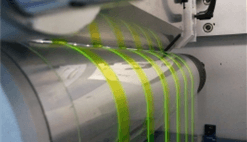Light-Emitting Electrochemical Cells now on Film
on

Researchers at Umea University (Sweden) have produced organic light-emitting electrochemical cells (LECs) using a roll-to-roll process under ambient conditions. The manufacturing technology developed by the Swedish team has potential for producing extremely thin light emitting foils for display applications using an inexpensive process. With further development, the foils also could be used for lighting applications.
The team focuses on novel organic compounds (such as light-emitting and conducting polymers and graphene) and development of LECs based on these materials. The researchers say they have dramatically improved the energy efficiency and lifetime of LECs. They have also demonstrated the unique physics and chemistry behind their operation, and they recently enhanced the performance of LECs to a point where they were suitable for signage applications.
The next step was to ensure that manufacturing costs could be attractive for commercial applications. According to a report published in Nature Communications, the team deposited a light-emitting layer and a PEDOT-PSS anode on a flexible cathode-coated substrate mounted on a roll, using only air-stable materials in a roll-coater apparatus. The layers in the resulting LEC were found to be highly uneven, and the active and anode layers were found to be very thick at approximately 1 µm. However, due to the unique self-doping action of the LEC, the emitted light did not suffer from the rough interfaces and was in fact found to be very uniform. This feature is ideal for roll-to-roll processes because it allows coating quality requirements to be relaxed, thus lowering costs substantially.


Discussion (0 comments)